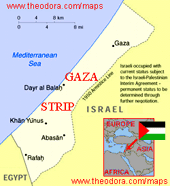Gaza Strip Under Siege
The Gaza Strip has been the epicenter of an intense Israeli bombardment over the past five days, following a deadly attack by Hamas. Human rights groups are condemning this as collective punishment of the enclave’s 2.3 million residents. Gaza’s situation is on the brink of a humanitarian crisis, with hospitals overwhelmed and the territory facing a complete blockade due to Israel’s intensified 16-year siege.
The Gaza Strip: A Snapshot
- Home to 2.3 million people in a small area of 365 sq km, making it one of the most densely populated places globally.
- Population density is at 5,500 people per sq km, in stark contrast to Israel’s 400 people per sq km.
- Approximately 65% of the population is under the age of 24, with a median age of 18 for both men and women.
- The enclave has faced a 16-year Israeli land, air, and sea blockade, severely impacting its economy and people’s mobility.
- Special permission is required for residents to cross into Israel and Egypt, often for urgent medical treatment.
- Gaza’s unemployment rate stands at 45%, making it one of the highest in the world.
- Access to education and medical treatment is compromised due to years of Israeli airstrikes on schools and hospitals.
- Palestinians and activists often refer to Gaza as the world’s largest “open-air prison” due to the Israeli blockade.
- The majority of the population is Muslim, with a small Christian minority.
- Over 60% of Gaza’s residents are refugees from what is now Israel, stemming from the 1948 Israeli declaration of independence, which resulted in the ethnic cleansing of Palestinians from their homes.
The Total Siege and Its Implications
- Israel announced a “total blockade” of Gaza, including restrictions on food, water, fuel, and electricity supplies.
- Gaza relies on electricity from Israeli power lines, and some power is generated within Gaza, often using fuel from Israel.
- Internet connectivity has deteriorated since the conflict escalated.
Location and Governance
- Gaza is a 10 km by 41 km strip on the Mediterranean Sea and is one of two Palestinian territories, the other being the West Bank.
- It is bordered by Israel to the north, east, and west, with a southern border crossing into Egypt.
- Israel maintains full control of Gaza’s borders, airspace, and territorial waters, despite formally withdrawing its forces in 2005.
- The Gaza Strip’s boundaries were defined in a 1949 Egyptian-Israeli armistice agreement.
- In 2006, Hamas won elections against the Fatah party and took control of Gaza in 2007, while the Palestinian Authority governs the West Bank.
- Since 2005, Israel has conducted at least six major military offensives in Gaza, with 2014 being the most brutal.
Roots of the Ongoing Conflict
- Hamas, which does not recognize Israel, seeks an independent Palestine based on the 1967 borders and demands an end to the Gaza blockade and Israeli occupation of Palestinian territories.
- Israel has continued expanding settlements in Palestine, contravening the 1993 Oslo Accords, which Hamas did not sign. This has raised tensions and threatens the possibility of a future Palestinian state.
- The rise of extreme-right politicians, settler violence, and a pro-settler government have further escalated tensions.
Current Conflict
- Ongoing violence has resulted in over 1,000 Palestinians killed, and Israel has promised to avenge the deaths of at least 1,200 of its citizens.
- Israel has imposed a complete blockade, significantly affecting daily life and access to essentials for Gaza’s residents.
Month: Current Affairs - October, 2023
Category: International / World Current Affairs • Places in News Current Affairs








